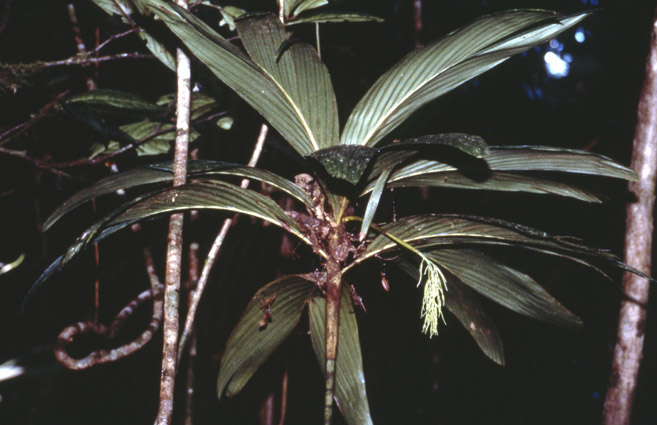- Acanthophoenix
- Acrocomia
- Actinokentia
- Actinorhytis
- Adonidia
- Aiphanes
- Allagoptera
- Ammandra
- Aphandra
- Archontophoenix
- Areca
- Arenga
- Asterogyne
- Astrocaryum
- Attalea
- Bactris
- Balaka
- Barcella
- Basselinia
- Beccariophoenix
- Bismarckia
- Borassodendron
- Borassus
- Brassiophoenix
- Burretiokentia
- Butia
- Calamus
- Calyptrocalyx
- Calyptrogyne
- Calyptronoma
- Carpentaria
- Carpoxylon
- Caryota
- Ceratolobus
- Ceroxylon
- Chamaedorea
- Chamaerops
- Chambeyronia
- Chelyocarpus
- Chuniophoenix
- Clinosperma
- Coccothrinax
- Cocos
- Corypha
- Cryosophila
- Cyphokentia
- Cyphophoenix
- Cyphosperma
- Daemonorops
- Deckenia
- Desmoncus
- Dictyocaryum
- Drymophloeus
- Elaeis
- Eleiodoxa
- Eremospatha
- Eugeissona
- Euterpe
- Gaussia
- Geonoma
- Guihaia
- Hedyscepe
- Hemithrinax
- Howea
- Hyophorbe
- Hyospathe
- Hyphaene
- Iriartea
- Iriartella
- Itaya
- Jailoloa
- Johannesteijsmannia
- Juania
- Jubaea
- Jubaeopsis
- Kentiopsis
- Kerriodoxa
- Korthalsia
- Laccospadix
- Laccosperma
- Lanonia
- Latania
- Lemurophoenix
- Leopoldinia
- Lepidocaryum
- Lepidorrhachis
- Leucothrinax
- Licuala
- Linospadix
- Livistona
- Lodoicea
- Lytocaryum
- Manicaria
- Manjekia
- Marojejya
- Masoala
- Mauritia
- Mauritiella
- Maxburretia
- Medemia
- Metroxylon
- Myrialepis
- Nannorrhops
- Nenga
- Neonicholsonia
- Neoveitchia
- Nephrosperma
- Normanbya
- Nypa
- Oenocarpus
- Oncocalamus
- Oncosperma
- Orania
- Oraniopsis
- Parajubaea
- Pelagodoxa
- Phoenicophorium
- Phoenix
- Pholidocarpus
- Pholidostachys
- Physokentia
- Phytelephas
- Pigafetta
- Pinanga
- Plectocomia
- Plectocomiopsis
- Podococcus
- Pogonotium
- Ponapea
- Prestoea
- Pseudophoenix
- Ptychococcus
- Ptychosperma
- Raphia
- Ravenea
- Reinhardtia
- Retispatha
- Rhapidophyllum
- Rhapis
- Rhopalostylis
- Roscheria
- Roystonea
- Sabal
- Sabinaria
- Salacca
- Saribus
- Satakentia
- Satranala
- Schippia
- Sclerosperma
- Socratea
- Solfia
- Sommieria
- Syagrus
- Synechanthus
- Tahina
- Tectiphiala
- Thrinax
- Trachycarpus
- Trithrinax
- Veitchia
- Verschaffeltia
- Voanioala
- Wallaceodoxa
- Wallichia
- Welfia
- Wendlandiella
- Wettinia
- Wodyetia
- Zombia
- x Jubautia splendens
- ?? Acoelorrhaphe
- ?? Bentinckia
- ?? Brahea
- ?? Clinostigma
- ?? Colpothrinax
- ?? Copernicia
- ?? Cyrtostachys
- ?? Dictyosperma
- ?? Dransfieldia
- ?? Heterospathe
- ?? Hydriastele
- ?? Iguanura
- ?? Incertae sedis & excluded names
- ?? Loxococcus
- ?? Micronoma
- ?? Paripon
- ?? Pritchardia
- ?? Rhopaloblaste
- ?? Serenoa
- ?? Washingtonia

Introduction
- A small palm with entire leaves, much-branched inflorescences, and didymous stamens; distinct, and presumably extinct as well. The species name is derived from the type locality. (Dransfield, J. & Beentje, H. 1995: The Palms of Madagascar)A
Distribution
Only known from a single collection from Betampona. (Dransfield, J. & Beentje, H. 1995: The Palms of Madagascar)A
Discussion
- The didymous stamens are very rare in entireleaved Dypsis species, and only D. catatiana, D. fanjana and D. singularis are similar in this respect. (Dransfield, J. & Beentje, H. 1995: The Palms of Madagascar)A
Biology And Ecology
- Lowland rain forest; c. 100 m (according to Jumelle & Perrier (1945); the type specimen gives no altitude). (Dransfield, J. & Beentje, H. 1995: The Palms of Madagascar)A
Conservation
- Presumed extinct: not seen for seventy years. Betampona has been visited by several palm collectors, including HB, in recent years. (Dransfield, J. & Beentje, H. 1995: The Palms of Madagascar)A
Common Name
- Not recorded. (Dransfield, J. & Beentje, H. 1995: The Palms of Madagascar)A
Uses
- Not recorded. (Dransfield, J. & Beentje, H. 1995: The Palms of Madagascar)A
Description
- Small palm to 1 m. LEAVES entire, with the sheath c. 11 cm long, 6.5 mm diam., with sparse reddish scales and c. 2 mm high auricles; petiole c. 6 cm long, 2.5-3 mm diam., with reddish scales; lamina 49- 52 cm long, midrib 21.5 cm, lobes 30 x 5.7 cm, main veins c. 7, with lines and bands of reddish scales, apices 0.8-1.8 cm wide, longdentate. INFLORESCENCE c. 63 cm, branched to 1 (2) order(s); peduncle c. 41 cm long, c. 2 mm diam., glabrous; prophyll c. 30 cm long, 1 cm wide, borne at 10.5 cm above the base of the peduncle, with scattered pale brown scales; peduncular bract inserted at c. 30 cm from the base of the peduncle, c. 12 cm long; rachis c. 16 cm long, with sparse long (1-2 mm) red curly hairs, especially in the axils of rachillae, with 1 branched and 22 unbranched first order branches, the branched one with 3 rachillae; rachillae reflexed, 3-5.2 cm, c. 1 mm diam., glabrous, with quite dense triads. STAMINATE FLOWERS with sepals imbricate, 0.6-0.8 x 0.8-1.1 mm; petals 0.8-0.9 mm high; stamens 6, biseriate, didymous, the filaments 0.2-0.25 mm long and connate at their bases, anthers 0.2-0.35 mm long and wide, in the type often with 4 fertile, 1 sterile and 1 missing or vestigial stamen; pistillode c. 0.2 mm high. PISTILLATE FLOWERS only known from very young buds, with sepals imbricate, the petals still enclosed within. FRUIT unknown. (Dransfield, J. & Beentje, H. 1995: The Palms of Madagascar)A
Materials Examined
- Toamasina: Betampona, Dec. 1925 (bud), Perrier 17469 (Holotype P). (Dransfield, J. & Beentje, H. 1995: The Palms of Madagascar)A
- Log in to post comments

